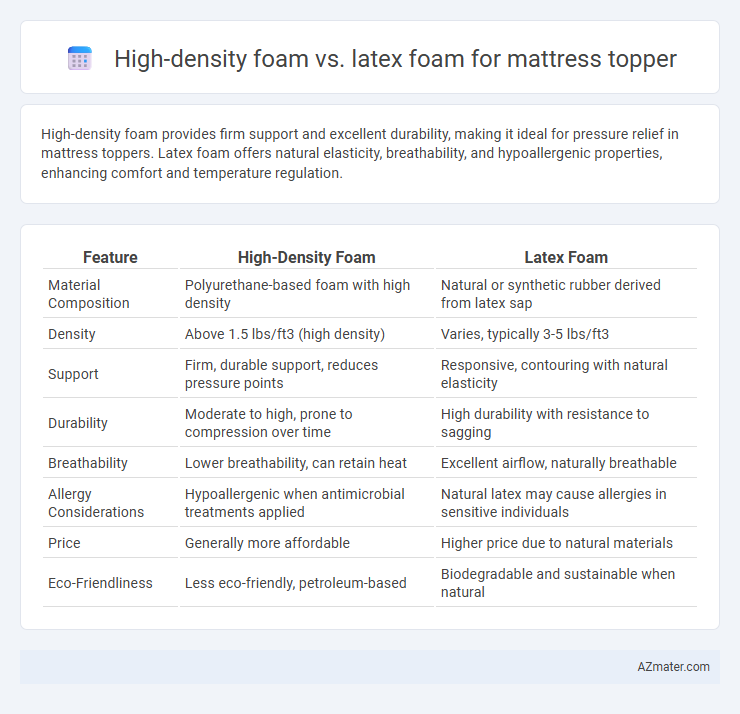High-density foam provides firm support and excellent durability, making it ideal for pressure relief in mattress toppers. Latex foam offers natural elasticity, breathability, and hypoallergenic properties, enhancing comfort and temperature regulation.
Table of Comparison
| Feature | High-Density Foam | Latex Foam |
|---|---|---|
| Material Composition | Polyurethane-based foam with high density | Natural or synthetic rubber derived from latex sap |
| Density | Above 1.5 lbs/ft3 (high density) | Varies, typically 3-5 lbs/ft3 |
| Support | Firm, durable support, reduces pressure points | Responsive, contouring with natural elasticity |
| Durability | Moderate to high, prone to compression over time | High durability with resistance to sagging |
| Breathability | Lower breathability, can retain heat | Excellent airflow, naturally breathable |
| Allergy Considerations | Hypoallergenic when antimicrobial treatments applied | Natural latex may cause allergies in sensitive individuals |
| Price | Generally more affordable | Higher price due to natural materials |
| Eco-Friendliness | Less eco-friendly, petroleum-based | Biodegradable and sustainable when natural |
Introduction to Mattress Topper Materials
High-density foam mattress toppers provide firm support with excellent durability and pressure relief, making them ideal for those seeking enhanced spinal alignment and motion isolation. Latex foam toppers offer natural elasticity, breathability, and hypoallergenic properties, combining comfort with eco-friendly benefits and resistance to dust mites and mold. Choosing between high-density foam and latex depends on preferences for firmness, responsiveness, and material composition in mattress topper performance.
What is High-Density Foam?
High-density foam is a type of polyurethane foam known for its durability and firm support, typically featuring a density of 1.8 pounds per cubic foot or higher. This foam offers excellent pressure relief and maintains its shape over time, making it ideal for mattress toppers that enhance spinal alignment and reduce body aches. High-density foam is often compared to latex foam, which provides a more responsive and breathable feel, but lacks the same level of firmness and longevity.
What is Latex Foam?
Latex foam is a natural or synthetic material derived from rubber tree sap, known for its durability, breathability, and resilience, making it ideal for mattress toppers. Unlike high-density foam, latex foam provides a responsive, buoyant support that contours to the body while maintaining cooler sleep temperatures due to its open-cell structure. The hypoallergenic and antimicrobial properties of latex foam also make it a preferred choice for allergy sufferers seeking a comfortable and long-lasting mattress topper.
Comfort and Support Comparison
High-density foam mattress toppers provide firm support with excellent pressure relief, making them ideal for individuals seeking enhanced spinal alignment and durability. Latex foam toppers offer a responsive, buoyant feel with natural breathability, promoting airflow and reducing heat retention for cooler sleep. The choice depends on whether you prioritize dense support and contouring (high-density foam) or elasticity and temperature regulation (latex foam).
Durability and Longevity
High-density foam offers excellent durability with its dense structure resisting sagging and compression over time, ensuring a longer lifespan for mattress toppers. Latex foam, especially natural latex, provides superior resilience due to its innate elasticity, maintaining support and shape for years without significant wear. Both materials excel in longevity, but latex foam typically outlasts high-density foam by several years, making it a preferred choice for long-term use.
Breathability and Temperature Regulation
High-density foam mattress toppers provide strong support but often retain heat due to their dense structure, limiting breathability and temperature regulation. Latex foam, especially natural latex, offers superior airflow and moisture-wicking properties, enhancing breathability and maintaining cooler sleep conditions. Choosing latex foam can significantly improve comfort for hot sleepers seeking effective temperature control.
Motion Isolation Performance
High-density foam mattress toppers offer superior motion isolation by absorbing and minimizing the transfer of movement across the bed surface, making them ideal for couples or light sleepers. Latex foam toppers provide moderate motion isolation with a more responsive and bouncy feel, but their inherent elasticity allows more motion transfer compared to dense memory foam. For optimal motion isolation performance, high-density foam remains the preferred choice due to its viscoelastic properties that contour closely to the body and dampen disturbances effectively.
Hypoallergenic and Health Considerations
High-density foam mattress toppers offer excellent support and durability but may emit volatile organic compounds (VOCs) that can affect indoor air quality, posing concerns for allergy-sensitive individuals. Latex foam, especially natural or organic latex, is inherently hypoallergenic, resistant to dust mites, mold, and bacteria, making it a healthier choice for those with respiratory issues or skin sensitivities. Choosing natural latex foam can minimize exposure to chemical irritants and promote better sleep hygiene compared to synthetic high-density foams.
Price and Value Analysis
High-density foam mattress toppers generally cost less than latex foam options, making them a budget-friendly choice for enhancing mattress comfort. Latex foam offers superior durability and natural hypoallergenic properties, which can provide better long-term value despite the higher initial price. Investing in latex foam often results in fewer replacements and improved sleep quality, justifying the premium for consumers seeking longevity and eco-friendly materials.
Which Mattress Topper is Right for You?
High-density foam mattress toppers provide firm support and excellent durability, ideal for sleepers seeking pressure relief and spinal alignment. Latex foam toppers offer superior bounce, natural hypoallergenic properties, and enhanced breathability, making them perfect for those sensitive to heat and allergens. Choosing between the two depends on your preference for firmness, temperature regulation, and material sensitivity.

Infographic: High-density foam vs Latex foam for Mattress topper
 azmater.com
azmater.com